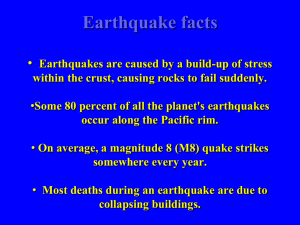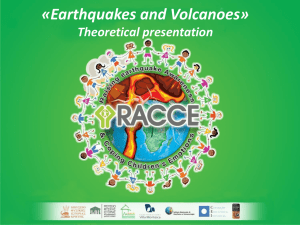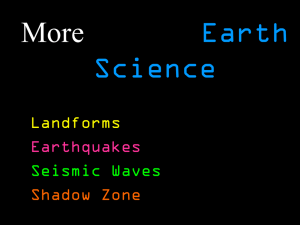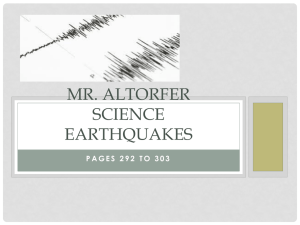of Earthquakes
advertisement
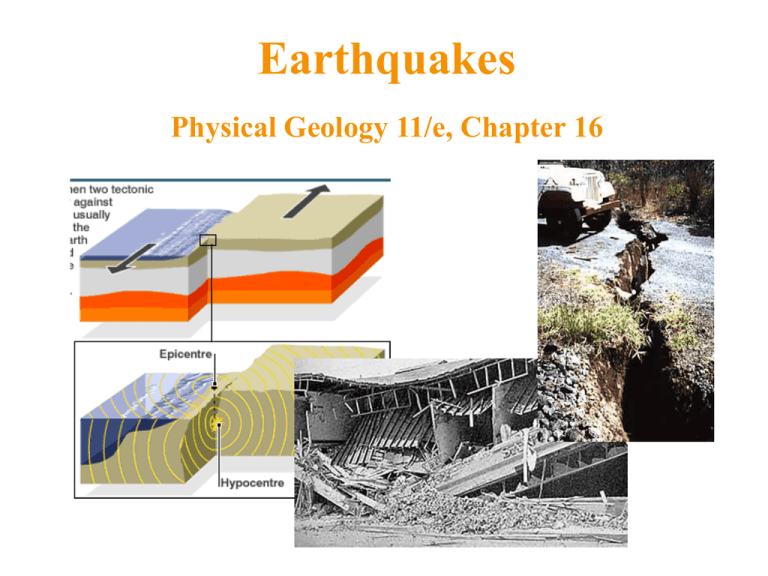
Earthquakes Physical Geology 11/e, Chapter 16 Earthquakes and Plate Tectonics • At divergent boundaries, – tensional forces produce shallow-focus quakes on normal faults • At transform boundaries, – shear forces produce shallow-focus quakes along strike-slip faults • At convergent boundaries, – compression produces shallow- to deep-focus quakes along reverse faults World Earthquake Distribution • Nearly all intermediate- and deep-focus earthquakes occur in Benioff zones – inclined seismic activity associated with descending oceanic plate at subduction zones) Most earthquakes occur at < 100 km depth Earthquakes can occur 100-670 km below the surface Causes of Earthquakes • Elastic rebound theory earthquakes are a sudden release of strain progressively stored in rocks that bend until they finally break and move along a fault Seismic Waves • Seismic waves originate at the focus (or hypocenter) - the point of initial breakage and movement along a fault • Epicenter - point on Earth’s surface directly above the focus (used for 2-D map) Types of Seismic Waves • Two types of seismic waves are produced during earthquakes – Body waves - travel outward from the focus in all directions through Earth’s interior – Surface waves - travel along Earth’s surface away from the epicenter Body Waves • P wave - compressional (longitudinal or push-pull) body wave in which rock vibrates back and forth parallel to the direction of wave propagation – Fast (4 to 7 kms/sec) wave that is the first or primary wave to arrive at recording station following earthquake – Pass through solids and fluids – P-P-P Body Waves • S wave - shearing (transverse) body wave in which rock vibrates back and forth perpendicular to the direction of wave propagation – Slower (2 to 5 km/sec) wave that is the secondary wave to arrive at recording station following earthquake – Pass through solids only (can’t travel through the outer core) – S-S-S Surface Waves • Slowest type of seismic waves produced by earthquakes – Love waves - side-to-side motion of the ground surface • Can’t travel through fluids – Rayleigh waves - ground to moves in an elliptical path opposite the direction of wave motion • Extremely destructive to buildings Measuring Earthquakes • Seismometers - used to measure seismic waves – Seismographs - recording devices used to produce a permanent record of the motion detected by seismometers Locating Earthquakes • P- and S-waves leave earthquake focus at the same time • P-wave gets farther and farther ahead of the S-wave with distance and time from the earthquake Locating Earthquakes • Plotting distances from 3 stations on a map, as circles with radii equaling the distance from the quake, locates earthquake epicenter • Depth of focus beneath Earth’s surface can also be determined – Shallow focus 0 - 70 km deep – Intermediate focus 70 - 350 km deep – Deep focus 350 - 670 km deep Measuring the “Size” of Earthquakes • Size of earthquakes measured in two ways - intensity and magnitude • Magnitude is a quantitative measure of the amount of energy released by an EQ – Richter scale • Logarithmic scale • Amplitude increased 10 times for every one step up scale • How much ‘worse’ is a mag.8 compared to a 6 EQ? Measuring the “Size” of Earthquakes • Moment magnitude - more objective measure of energy released by a major earthquake – Uses rock strength, surface area of fault rupture, and amount of movement – Smaller earthquakes are more common than larger ones Measuring the “Size” of Earthquakes • Intensity - a measure of the effects an earthquake produces (on both structures and people) – Modified Mercalli scale – Qualitative – Multiple values for one EQ • Amount of shaking controlled by amount of energy released (magnitude), distance from the focus, ‘soil’ type – Useful for assessing historical EQs Earthquake Risk • Large seismic risks or hazards exist around New Madrid, Missouri • Seismic risk determined based on the assumption that large future earthquakes will occur where they have occurred in the past Effects of Earthquakes • Liquefaction occurs when water-saturated soil or sediment sloshes like a liquid during a quake Tsunami • Tsunami (seismic sea waves) - very large sea waves caused by sudden upward or downward movement of the sea floor during submarine earthquakes Earthquake Prediction and Seismic Risk • Accurate and consistent shortterm earthquake prediction not yet possible • Three methods assist in determining probability that an earthquake will occur: – Measurement of changes in rock properties due to buildup of strain • magnetism, electrical resistivity, seismic velocity, porosity, etc. – Studies of the slip rate along fault zones – Paleoseismology studies Earth’s Interior and Geophysical Properties Physical Geology 11/e, Chapter 17 Evidence from Seismic Waves • Seismic waves or vibrations from a large earthquake (or underground nuclear test) will pass through the entire Earth – Affected by the properties of Earth materials, • Density and state (solid or liquid) may result in changes in seismic wave velocity, reflection, refraction, or both reflection and refraction. • Allow geologists to ‘see’ into the Earth Evidence from Seismic Waves • Seismic reflection - the return of some waves to the surface after bouncing off a rock layer boundary – Sharp boundary between two materials of different densities will reflect waves Evidence from Seismic Waves • Seismic refraction - bending of seismic waves as they pass from one material to another with different seismic velocities – V2 > V1 = ‘upward’ refraction – V2 < V1 = ‘downward’ refraction • Seismic velocity (and density) of the mantle increases uniformly with depth – Curved ray paths result because the wavefronts are continuously refracted Earth’s Internal Structure • The crust, mantle and core, the three main layers within the Earth, have been determined based on seismic evidence. The Crust • • • The crust is the outer layer of rock that forms a thin skin on Earth’s surface Seismic wave studies indicate that the crust is thinner and denser beneath the oceans than on the continents Seismic wave velocities are different in oceanic (7 km/sec) vs. continental (~6 km/sec) crustal rocks – Indicate different compositions • Oceanic crust is mafic – Primarily of basalt and gabbro (basaltic and gabbroic) • Continental crust is felsic – Average composition is similar to granite and rhyolite (granitic and rhyolitic) Crust-Mantle Boundary • The crust-mantle boundary, called the Mohorovičić discontinuity or Moho, is marked by a jump in seismic wave velocity. The Mantle • • • • • • The mantle is a thick shell of dense rock that separates the crust above from the core below Seismic wave studies indicate the mantle, like the crust, is made of solid rock with only isolated pockets of magma Higher seismic wave velocity (8 km/sec) of mantle vs. crustal rocks indicate denser, ultramafic composition Crust + upper mantle = lithosphere, the brittle outer shell of the Earth that makes up the tectonic plates Lithosphere averages 70 km thick beneath oceans and 125-250 km thick beneath continents Beneath the lithosphere, seismic wave speeds abruptly decrease in a plastic low-velocity zone called the asthenosphere The Core-Mantle Boundary • Core-mantle boundary (D” layer) is marked by great changes in seismic velocity, density and temperature – P-wave velocitites dramatically decrease • Ultralow-velocity zone (ULVZ) – Due to hot core melting lowermost mantle or reacting chemically to form iron silicate ‘sediments’ The Core • The core is the metallic central zone of the Earth – Subdivided into a liquid outer core and solid inner core • Seismic wave studies have provided primary evidence for existence and nature of Earth’s core The Outer Core • Seismic shadow zones – Specific areas on the opposite side of the Earth from large earthquakes do not receive seismic waves – S-wave shadow zone (≥103° from epicenter) suggests outer core is liquid • Liquids have no shear strength – P-wave shadow zone (103°-142° from epicenter) explained by refraction of waves encountering core-mantle boundary • Decreased velocity causes wavefront to be refracted ‘downward’ The Inner Core • • Careful observations of P-wave refraction patterns indicate that inner core is solid Core composition inferred from its calculated density, physical and electro-magnetic properties, and composition of meteorites – Iron metal (liquid in outer core and solid in inner core) best fits observed properties – Iron is the only metal common in meteorites Isostasy • Isostatic adjustment - rising or sinking of crustal blocks to achieve isostatic balance – Crust will rise when large mass is rapidly removed from the surface, as at end of ice ages – Rise of crust after ice sheet removal is called crustal rebound • Rebound still occurring in northern Canada and northern Europe Gravity Measurements • Gravity meters - detect tiny changes (anomalies) in gravity at Earth’s surface related to total mass beneath any given point – Gravity slightly higher (positive gravity anomaly) over dense materials (metallic ore bodies, mafic rocks) – Gravity slightly lower (negative gravity anomaly) over less dense materials (caves, water, magma, sediments, felsic rocks) Earth’s Magnetic Field • A magnetic field (region of magnetic force) surrounds the Earth – Field has north and south magnetic poles – A compass detects Earth’s magnetic field – Recorded by magnetic minerals (e.g., magnetite) in igneous rocks as they cool Earth’s Magnetic Field • Magnetic reversals - times when the poles of Earth’s magnetic field switch – After next reversal, a compass needle will point toward the south magnetic pole – Direction recorded in magnetic minerals – Minerals also recorded the time that they formed • Radioactive decay • Reversals have occurred many times • Timing appears chaotic, no discernable pattern Magnetic Anomalies • • Positive and negative magnetic anomalies represent larger and smaller than average local magnetic field strengths, respectively Can detect metallic ore deposits, igneous rocks (positive anomalies), and thick layers of non-magnetic sediments (negative anomaly) beneath Earth’s surface Heat Flow Within Earth • Geothermal gradient - temperature increase with depth – Tapers off sharply beneath lithosphere – Due to steady pressure increase with depth, increased temperatures produce little melt (mostly within asthenosphere) except in the outer core The Sea Floor Physical Geology, Chapter 18 form? Continental Shelves & Continental Slopes • Continental shelf: shallow, submarine platform, 0.1º seaward dip • Continental slope: 4-5º steep slope from a depth of 100-200 m at edge of continental shelf Submarine Canyons Submarine canyons: V-shaped valleys that run across continental shelves & slopes Abyssal fans: fan-shaped deposits of sediment at base of submarine canyons Turbidity currents: masses of sediment-laden water pulled downhill by gravity Passive Continental Margins • Passive continental margin: – Continental shelf, continental slope, and continental rise. – Extends to abyssal plain at 5 km depth. • Continental rise: at base of continental slope, wedge of sediment from continental slope to deep-sea floor, slopes 0.5º. Passive Continental Margins Continental Rise: Types of deposition • Turbidity currents – flowing down slope • Contour currents – flowing along slope Passive Continental Margins Abyssal Plains • Abyssal plains: – Very flat regions at base of continental rise. – Composed of horizontal sediment layers probably deposited by turbidity currents. – Flattest features on the Earth. Active Continental Margins • Active continental margin: – Earthquakes, young mountain belt, and volcanoes. – Consists of continental shelf & slope, and oceanic trench. – Lacks continental rise and abyssal plain. – Associated with convergent plate boundaries. Active Continental Margins Oceanic Trenches • Oceanic trench: – Narrow, deep trough parallel to edge of continent or island arc – Continental slope steepens to 10-15º – Benioff seismic zone – Volcanoes landward – Low heat flow – Negative gravity anomaly Mid-Oceanic Ridges • Mid-oceanic ridge: – – – – – Undersea mountain range Basalt 80,000 km long 1500-2500 km wide 2-3 km above ocean floor • Rift Valley: – – – – – Crust extension Along ridge crest 1-2 km deep Several km wide Present in Atlantic & Indian Ocean, absent in Pacific Ocean North America • Fracture zones: – Major lines of weakness of the Earth’s crust – Cross MOR at right angles – Rift valley is offset – May extend onto continents Seamounts, Guyots, & Aseismic Ridges • Guyots: Flattopped seamounts • Aseismic ridges: Submarine ridges not associated with earthquakes. Reefs • Reefs: – Wave resistant ridges of coral, algae, & other calcareous organisms – Warm, shallow, sunlit, clean water – Reef types • Fringing reefs: Flat table-like, attached directly to shore • Barrier reefs: parallel to shore, detached by lagoons • Atolls: Circular reefs rimming lagoons, surrounded by deep water Sediments of the Sea Floor • Basaltic oceanic crust • Terrigenous sediment: – Land-derived sediment. – Turbidity & contour currents • Pelagic sediment: – Fine-grained clay & skeletons of microscopic organisms. – Absent on ridge crests. Oceanic Crust & Ophiolites • Oceanic crust is thinner (7 km) and denser (3.3 g/cm3) than continental crust. • Layer 1: Marine sediment (variable thickness & composition). • Layer 2: 1.5 km, pillow basalts overlaying basalt dikes (closely spaced, parallel, vertical). • Layer 3: 5 km sill-like gabbros. • Ophiolite: Slivers of oceanic crust emplaced on land represented by distinctive rock sequences
